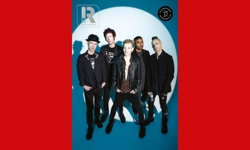As a pure play digital content brand with 22m unique users each month and revenue up 20% year on year in 2013 - you'd be forgiven for thinking Digital Spy has it made. But profile for the UK's self-proclaimed "largest, dedicated entertainment site" remains an issue for editor David Moynihan who says that building brand recognition will be the next big challenge for the brand.
We meet in the weeks following Digital Spy's redesign, its most comprehensive since launch back in 1999. The look of everything from the logo down has changed, but the site's fans' reception has so far been warm and its owner, Hearst Magazines UK, is bullish about future prospects.
"December's redesign marked the first phase, an aesthetic update which has been really important - because we've now got a beautiful site that reflects the quality of our content," explains Moynihan, Web Editor of the Year (Consumer) at the BSME Awards 2013 at which Digital Spy also won Media Editorial Team of the Year.
There's no time for laurels-resting, however, as he talks of the need for continuous improvement: "Because the environment in which we exist is always shifting, rapidly, which makes product development online a never-ending story."
After stints at IPC editing NME.com and editing FHM.com at Bauer, Moynihan took over as editor almost three years ago from Digital Spy co-founder and former editor Neil Wilkes.
Bedroom roots
Wilkes had launched Digital Spy from his bedroom when he was just sixteen as an online arena for discussing the emerging world of digital TV. Working closely with business partner James Welsh, he then evolved the site over a number of years.
Initially powered by student journalists wanting to make their mark, Digital Spy developed a growing array of content - not just about TV but related areas of entertainment of interest to users such as movies, showbiz, technology and gaming - with news supplemented by features and interviews, reviews and quizzes.
Equally important, however, were (and still are) the Digital Spy forums - an extension of Wilkes' original idea to create a discussion platform - which today have around 550,000 registered users, including big name content posters such as Lord Sugar and Courtney Love.
Dialogue and, sometimes, collaboration - information sharing, for example - between writers and forum users remains an important part of the Digital Spy mix.
So traffic grew, and when funds were needed to upgrade the servers required to meet this growing volume, Wilkes and Welsh received help from IMDb.com co-founder Alan Jay. Digital Spy started selling advertising. Then, in 2008, it was sold for an undisclosed but, reportedly, "significant" sum to magazine company Hachette which, three years later, was acquired by Hearst.
Today, then, Digital Spy sits within the portfolio of Hearst Magazines UK with no direct UK rival - though when pressed, Moynihan talks of competition for certain sections of the site from niche specialists, such as film magazine Empire, or, for soaps, the tabloid press. The closest rivals, it seems, are in the US - home to numerous entertainment sites, such as Entertainment Weekly and Vulture.com, run by New York Magazine.
Digital Spy now serves more than 145 million pages of content to over twenty million unique visitors each month. Its audience is mainstream and diverse though with a younger skew and, overall, evenly split between men and women. And at least 200 new pieces of content go up on the site each day. Which explains why usability is now a strategically important focus.
"(Prior to the recent redesign) we felt we had some fantastic content being published each day that perhaps wasn't getting the visibility that it deserved," Moynihan explains. "Now, our new home page enables us to re-curate what we feel are the site's highlights each day - be that news or non-news content such as video interviews, video features, picture-based content, opinion pieces or interviews."
Digital engagement
It's all about improving engagement which, pre-redesign, was already strong but needed to be even better.
Data from last year shows that one third of visitors visit the site more than 50 times a month while the figure for 15% is a staggering 200 times. The reason for such impressive figures is the site's depth and passion for its content, Moynihan says: another important pillar moving forwards.
"One of our mantras is 'by fans, for fans'," he explains. "So we've an expert team split into verticals - a music team, a movies team, a soaps team, and so on. And these writers are expert and obsessive about what they cover."
Resources are limited, of course, so the choice of which entertainment products and brands to cover is dictated by scale - the biggest products; quality - the best, even if they are less well-known; and passion - in other words: products and brands that spark both the writers' and readers' greatest interest.
"Take 'Sherlock', for example. We have exhaustive news relating to the show, fantastic relationships with the talent behind the show - therefore some great video interviews and exclusive scoops about what's coming up, and incredible writers doing some of the best writing on the web in terms of re-caps and reviews," Moynihan claims.
News driven
"By and large, our engagement levels come down to the fact that when someone is a fan of something, Digital Spy provides them with a 24/7 way of really enjoying the thing they love with constantly updated content about it. News is very much the engine of the site."
Digital Spy has twenty staff based in its Soho office and a further twenty staff and freelance contributors who work from home and out of Hearst's US headquarters. The team includes a subs desk with a subbing process that's sufficiently well-oiled to ensure a piece of content can be written and out online "in just a few minutes".
It's not just about being first and fastest, however.
"We also want to be the most entertaining and interesting, so we have increased our focus in recent years on non-news content. It's about giving people reasons to come back every time, even if a news story about what they love hasn't just broken," he adds.
"The IAB published some interesting research the other day showing that smartphone users - and over half of our users access us by mobile now - generally look at the internet on their phone sixteen times a day for two minutes each time. So it's about trying to make sure that when they reach for their phone to do this, Digital Spy is front of mind."
Redesigned article templates now more effectively direct visitors to related and relevant content. And over the weeks and months ahead, the team will explore other ways to further improve usability.
One possible future development is the introduction of responsive web design. Currently, Digital Spy has a separate mobile site. However it is considering the benefits of a single site optimised to work across any and every platform. And then there is never-ending pages - an approach to online content publishing in which the reader never needs to click 'next page'.
"Such developments raise a whole bunch of questions. For example: will a page impression matter anymore once a user can just keep scrolling to find more and more content," Moynihan observes. "But identifying and creating the best possible user experience is what enables you to make the most of the opportunities editorially and commercially."
Move away from display
On the commercial side, 100% of revenue comes from advertising and recent growth has been driven by two factors. The first is Digital Spy's efforts under Hearst's ownership to shift its emphasis from display advertising to 'creative solutions': commercial partnerships, sponsorship and native advertising. The second, is video.
"We are consistently delivering 1m video streams a month, too. So pre-roll is a great revenue source for us with considerable further potential," he says. Digital Spy has recently developed a number of weekly video franchises, too, such as Screen Time which is sponsored by Blinkbox.
Another important pillar of Digital Spy's business is social media which it uses to distribute content, generate referrals and drive traffic to the site.
"Twitter is great for breaking news and we have a constant feed of headlines. But it is also a great way of reaching people, and our writers tweet during selective programmes to engage directly with fans," Moynihan continues.
"Facebook is a way for us to selectively present content highlights around the clock. Both enable people to interact with the brand when they're not on the website."
Social media is also an important way of building brand recognition and profile - through referrals. Because, as Moynihan readily admits, building profile can be a particular challenge for a digital-only brand.
"I love being purely digital - and I've worked on multiplatform titles, and still relish reading newspapers and magazines. And websites are an increasingly enjoyable and important part of the mix now. But there are pros and cons of having a print product," he says.
"It's great to be incredibly fast and reactive and not have to worry about working differently for different parts of the brand. There is strength in being able to focus just online. But for many people, a physical magazine is still an incredibly powerful thing. Stars still want to be on magazine covers, and I think some of the best writing - and the best pictures - are still found to a consistent and a very high level in magazines."
Which is why, intriguingly, he adds Digital Spy "would never rule out" having some kind of a print product spin-off at some point in the future. Just like publishing digital magazine editions of Digital Spy focused on a particular subject "is not beyond imagination".
And then there's the possibility of broadening its footprint and focus beyond the UK (75% of its current users are UK-based). "US expansion is a very interesting idea," he readily admits.
"We've already got a team out there writing about US shows and stars, so there's a huge opportunity there. Though whatever we do, we've got to ensure the key tenets will always remain the same: to deliver fantastic content about the quality entertainment and technology that we love."












